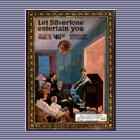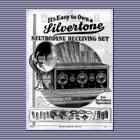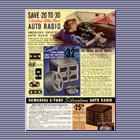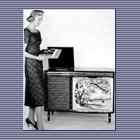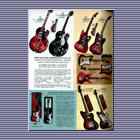|
It has been 30 years since Sears ended its association with
the Silvertone brand, but the public's association is so strong
to this day that many still believe Silvertone is a Sears brand.
It is a testament to the success and quality of Sears'
Silvertone products that the public still associates the two
names so closely. The Sears Silvertone radio and Silvertone
guitar, two highly collectible items today, are largely
responsible for America's fond recollection of the Sears-Silvertone
connection.
In 1915, Sears introduced the Silvertone phonograph, a
hand-cranked machine that came in tabletop and freestanding
models. All phonographs came with a two-week, money-back
guarantee.
Sears began selling Silvertone radios in the early 1920s,
soon adding Silvertone radio tubes and batteries to the product
line. In the late 1930s, however, Silvertone radios quickly
took off in popularity. The era corresponded with the outbreak
of military aggressions in the Pacific theater. With the
approach of World War II, increasing numbers of people wanted
radios not just for entertainment, but also to receive updates
on the war's progress, according to contemporary company sales
analyses.
During World War II, Sears introduced the Silvertone radio
antenna with "stratobeam reception." And to help power
the radios, Sears sold Silvertone wind generators.
Today, the Internet is filled with pages of Sears Silvertone
radio collections and information about the antique radios.
Their designs, particularly the stylish use of plastic casing,
continue to be very popular among radio collectors.
The Silvertone name replaced the Supertone brand on musical
instruments in the 1930s. Struggling blues musicians of the
1940s and 1950s first popularized the Silvertone guitar, with
legends such as Muddy Waters and Arthur "Big Boy"
Crudup among those who played Silvertones.
The Sears Silvertone guitar really made its mark in music
history as the unofficial "first guitar" of guitar's
icons. Chet Atkins, Bob Dylan and Jimi Hendrix, among many
others, played their first chords on a Sears Silvertone. Sears'
guitars have even been immortalized by their mention in songs
from artists as diverse as Mary Chapin Carpenter ("Girls
With Guitars") and G. Love and Special Sauce ("Blues
Music").
Silvertones were popular with young musicians because of
their solid construction and inexpensive pricing. Their
legacy lives on today as literally hundreds of Internet pages
are filled with fond recollections from people of their first
guitar, the Sears Silvertone. As with the Silvertone radio,
Sears Silvertone guitars are considered prized pieces of many
guitar collections, particularly models such as the 1963
"amp-in-case" guitar, which featured an amplifier
built into the guitar's carrying case.
Many other musical and audio items bore the Silvertone brand
name. Sears introduced a Silvertone record label in the 1920s,
featuring many of the era's most popular recording artists. In
the 1950s and early 1960s, the Silvertone brand name appeared on
all Sears electronic equipment, including console televisions,
tape recorders, walkie-talkies, radio batteries, hearing aids
and car radios.
By the end of the 1960s, the Silvertone brand name was only
appearing on musical instruments and the top-of-the-line stereo
equipment and televisions. Silvertone products last appeared in
the spring 1972 catalog on televisions and stereo systems.
|


